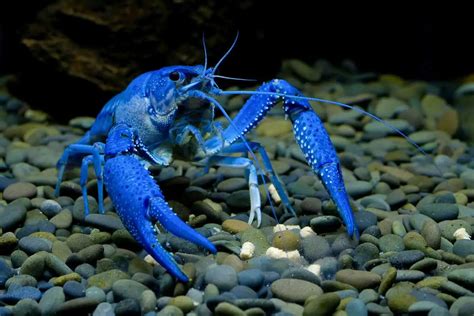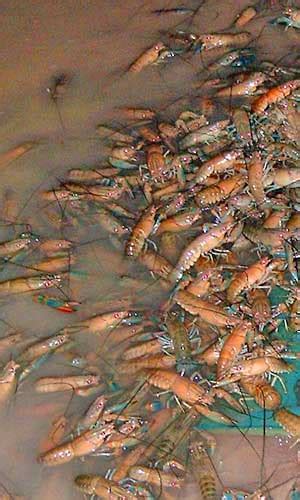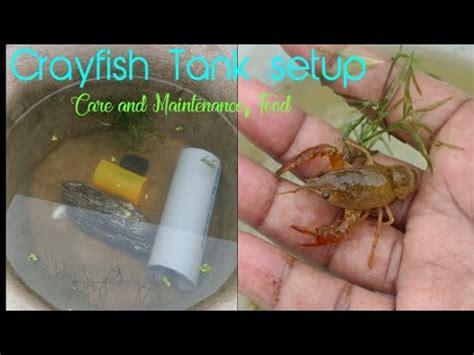Indulging in the captivating world of crustaceans is a fascination harbored by countless individuals seeking to cultivate a unique and rewarding hobby. The allure of acquiring and nurturing crayfish is a pursuit that unveils an enchanting realm of multicolored exoskeletons, delicate appendages, and captivating behaviors.
Exploring the diverse array of crayfish species, each possessing their own distinct characteristics and requirements, offers an unparalleled opportunity for adventure and discovery. With their stunning hues and mesmerizing patterns, crayfish have become a sought-after addition to many home aquariums, allowing enthusiasts to create miniature aquatic ecosystems teeming with life and intrigue.
However, embarking on this voyage requires more than just mere fascination. It entails a deep understanding of the intricacies surrounding crayfish care, encompassing habitat design, dietary considerations, and crucial water parameters. By acquiring the knowledge necessary to provide optimal conditions for these intriguing creatures, enthusiasts can aspire to create thriving environments that mirror the wonders of their natural habitats, fostering the health and happiness of their newfound companions.
Understanding the Basics: Types and Varieties of Crayfish

In this section, we will explore the fundamental aspects of crayfish morphology and taxonomy. By gaining a deeper understanding of the various types and varieties of crayfish, you will be better equipped to choose the perfect specimen for your desired aquaculture setup.
Morphology:
Before delving into the specific types and varieties, it is crucial to grasp the basic morphology of crayfish. These fascinating crustaceans possess segmented bodies, with a tough outer exoskeleton that provides protection. They have a distinct pair of pincers, or chelae, which vary in size and shape depending on the species. Additionally, crayfish have two pairs of antennae, one shorter pair for sensing touch and another more extended pair for detecting chemicals in the water.
Taxonomy:
There are numerous types and varieties of crayfish, each with its own unique characteristics and distribution. Crayfish belong to the order Decapoda, meaning "ten feet," which includes other crustaceans such as crabs and lobsters. Within the order Decapoda, crayfish fall under the infraorder Astacidea. From there, they are further classified into various families, genera, and species based on their specific traits and geographic location.
Native vs. Non-native Species:
It is worth noting that crayfish species can be either native or non-native to a particular region. Native species are those that have naturally occurred in an area for an extended period, while non-native species have been introduced through human activities. Understanding the distinction between native and non-native crayfish is essential, as it can affect their impact on the ecosystem and their suitability for aquaculture purposes.
Popular Varieties:
Within the crayfish realm, there are several popular varieties that enthusiasts commonly keep. Some of the well-known ones include the Red Swamp crayfish (Procambarus clarkii), the White River crayfish (Faxonius potosiensis), and the Electric Blue crayfish (Procambarus alleni). Each of these varieties boasts its distinct aesthetic appeal and behavioral characteristics, making them highly sought after among crayfish enthusiasts.
Conclusion:
By familiarizing yourself with the basics of crayfish types and varieties, you will be able to make informed decisions when it comes to selecting the crayfish that best aligns with your aquaculture goals. Remember to consider factors such as morphology, taxonomy, native vs. non-native species, and popular varieties to ensure a successful and enjoyable crayfish ownership experience.
Finding the Ideal Crayfish Tank: Creating the Perfect Habitat
Creating an optimal habitat is crucial when it comes to setting up a tank for crayfish. In this section, we will explore the essential factors to consider and the steps to follow in order to establish the perfect environment for your crayfish. By providing them with the ideal conditions, you can ensure their well-being and help them thrive in their new home.
First and foremost, it's important to choose a suitable tank size for your crayfish. Adequate space allows for their natural movement and reduces the potential for stress. Consider the number of crayfish you plan to keep and choose a tank that provides enough room for them to roam, explore, and establish their territories.
Next, pay attention to the tank's water quality. Crayfish require clean and well-maintained water to thrive. Regular water changes, proper filtration, and monitoring of chemical levels are essential for maintaining optimal water conditions. Be mindful of the specific water requirements of the crayfish species you plan to keep, as these may vary.
Another crucial aspect is the tank's temperature and lighting. Crayfish are sensitive to changes in temperature, so it's important to provide a stable and suitable environment. Research the temperature requirements of your chosen crayfish species and invest in a reliable aquarium heater to maintain the desired warmth. Additionally, appropriate lighting is necessary for the biological rhythms of the crayfish, contributing to their overall well-being.
In addition to the physical environment, it's crucial to consider the tank's decor and hiding spots. Crayfish are natural burrowers, so providing them with various objects, such as rocks, caves, or plants, allows them to feel secure and establish their territories. These features also offer opportunities for exploration and stimulation, contributing to their overall mental and physical health.
Finally, keep in mind that crayfish are opportunistic omnivores, so their diet should consist of a variety of food sources. Feed them a balanced diet, including high-quality commercial crayfish pellets, invertebrates, and vegetables. Proper nutrition will support their growth and ensure their overall health and vitality.
In summary, when setting up a crayfish tank, consider the tank size, water quality, temperature and lighting, tank decor, and diet. By optimizing these factors, you can create an ideal habitat that promotes the well-being and happiness of your crayfish, allowing them to flourish in their new home.
Essential Equipment and Supplies: What You Need to Get Started

In order to begin your journey in the world of crayfish, there are a number of essential equipment and supplies that you will need to have. These items will ensure that you are fully equipped to create an optimal environment for your crayfish and provide them with the necessary care they require.
Aquarium Tank: The first and foremost item on your list should be a suitable aquarium tank. Consider the size and space requirements of crayfish, as they need ample room to move around and hide. A tank with a capacity of at least 10 gallons is recommended for a single crayfish.
Water Filtration System: Keeping the water in your crayfish tank clean and healthy is crucial for their well-being. Invest in a reliable water filtration system that is suitable for the size of your tank. This will help keep the water free from impurities and maintain optimal water conditions.
Heater: Crayfish thrive in a temperature range of 65-75 degrees Fahrenheit (18-24 degrees Celsius). To maintain a consistent temperature in your tank, invest in a heater that is specifically designed for aquariums. This will ensure that your crayfish remain comfortable and healthy.
Substrate: Crayfish like to dig and burrow, so providing them with a suitable substrate is essential. Opt for gravel or sand as a substrate, as this will allow your crayfish to engage in natural behaviors like digging, hiding, and constructing burrows.
Decorations and Hiding Places: Creating an enriching environment for your crayfish includes providing them with hiding places and decorations. Rocks, driftwood, and PVC pipes can serve as great options to create hiding spots and add visual interest to the tank.
Food and Feeding Supplies: Lastly, ensure that you have an adequate supply of crayfish food. Crayfish are omnivorous and will eat a variety of foods, including pellets, vegetables, and protein-rich sources like worms or shrimp. Additionally, you will need feeding supplies such as a food dish or feeding tongs to easily serve their meals.
Taking the time to gather the necessary equipment and supplies will not only enhance the well-being of your crayfish but also contribute to the overall enjoyment of your experience as a crayfish owner.
Choosing Healthy Crayfish: Signs to Look Out For
When it comes to selecting the perfect crayfish for your desired culinary experience, knowing how to identify healthy specimens is crucial. Recognizing the signs of a healthy crayfish not only ensures the quality of your dish but also contributes to the overall success of your dining experience.
- Shell Condition: A crucial factor in determining the health of crayfish is the condition of their shells. Look for crayfish with intact shells that are free from visible cracks or discoloration. Healthy crayfish will have a shiny and vibrant shell, indicating good overall well-being.
- Activity Level: Active crayfish can be a good indicator of their health. Choose crayfish that are moving around and demonstrating responsiveness. Avoid individuals that appear lethargic or disinterested, as they may be experiencing health issues.
- Size and Weight: Another important aspect to consider when selecting crayfish is their size and weight. Opt for specimens with a substantial size and weight, as this typically suggests a well-developed crayfish with a high likelihood of being healthy.
- Appendage Strength: The strength and mobility of a crayfish's appendages, including their claws and legs, is a good indication of their health. Select individuals with sturdy appendages capable of gripping and moving with ease.
- Coloration: While crayfish can vary in color, it is important to choose individuals with vibrant and consistent coloration. Avoid specimens with pale or dull colors, as this can signify potential health issues.
- Infection or Parasites: Carefully inspect each crayfish for any signs of infections or parasites. Look out for abnormal growths, lesions, or visible signs of infestation. Healthy crayfish should be free from any such indications.
By paying attention to these signs when purchasing crayfish, you can ensure that you are obtaining healthy and high-quality individuals. Remember, the health of the crayfish you choose will ultimately contribute to the enjoyment and satisfaction of your culinary endeavors.
Feeding Your Crayfish: Optimal Approaches and Nutritional Needs

Ensuring proper nutrition for your crayfish is essential for their overall health and well-being. This section will provide you with valuable insights into the best practices and nutritional requirements to effectively feed your crayfish.
Feeding your crayfish involves meeting their specific dietary needs, which consist of a balanced combination of proteins, carbohydrates, fats, vitamins, and minerals. By providing a varied diet, you can mimic their natural feeding habits and promote their growth and vitality.
| Type of Food | Description | Benefits |
|---|---|---|
| High-Quality Pellets | Pellets specifically designed for crayfish, containing a well-balanced mix of nutrients. | Convenient to feed, precisely formulated to meet their nutritional needs. |
| Fresh Vegetables | Leafy greens, such as spinach and kale, as well as carrots and peas. | Provide essential vitamins and fiber, promote digestion, and add variety to their diet. |
| Protein-Rich Foods | Live or frozen options like bloodworms, brine shrimp, and daphnia. | Supply necessary protein for growth, reproduction, and overall development. |
| Calcium Sources | Crushed eggshells or cuttlefish bone for calcium supplementation. | Promote healthy molting and shell development, preventing shell deformities. |
It is crucial to feed your crayfish with small amounts of food at a time to avoid overfeeding, as they will eat until they are full. Uneaten food should be promptly removed to prevent water contamination. Regularly monitor their consumption and adjust the amount based on their needs.
Remember to observe your crayfish closely for any signs of dietary deficiencies, such as sluggishness or slowed growth. Consult a veterinarian or aquatic specialist if you suspect any health issues or have specific concerns about your crayfish's diet.
By following these best practices and providing a nutritionally balanced diet, you can ensure the well-being and longevity of your crayfish, allowing them to thrive in their aquatic environment.
Maintaining Water Quality: Ensuring the Well-Being of Your Crayfish
One of the key factors in keeping your crayfish happy and healthy is maintaining the quality of their habitat. Quality water conditions are crucial for their overall well-being and can significantly impact their behavior and longevity. In this section, we will discuss essential tips and techniques to help you maintain optimal water quality for your crayfish.
Water quality parameters, such as temperature, pH levels, and ammonia, nitrite, and nitrate levels, play a vital role in the health of crayfish. It is important to closely monitor these parameters regularly to ensure they are within the appropriate range. Deviations from the preferred conditions can lead to stress, disease, or even death for your crayfish.
A well-maintained aquarium or tank for your crayfish should include a filtration system to remove debris, excess food, and waste materials. Regular water changes are also necessary to dilute accumulated toxins and replenish essential minerals and nutrients. Performing these tasks on a scheduled basis will help provide a clean and stable environment for your crayfish.
Additionally, the choice of substrate and decorations in your crayfish habitat is worth considering. The substrate should be unbleached sand, gravel, or crushed coral, providing a suitable environment for burrowing. Natural hiding spots, such as rocks, caves, or driftwood, can also be added to create a more enriching and stimulating environment for the crayfish.
| Water Quality Parameters | Preferred Range |
|---|---|
| Temperature | 70-75°F (21-24°C) |
| pH Levels | Neutral to slightly alkaline (7.0-8.0) |
| Ammonia Levels | 0 ppm |
| Nitrite Levels | 0 ppm |
| Nitrate Levels | Below 20 ppm |
Regular water testing is crucial to ensure that these parameters remain within the appropriate range. Test kits are readily available in pet stores and can provide accurate readings for temperature, pH, and chemical components such as ammonia, nitrite, and nitrate.
By diligently maintaining water quality, you can create an optimal environment for your crayfish, promoting their overall health and well-being. With proper care and attention to their habitat, your crayfish will thrive and provide you with endless joy and fascination.
Handling and Safety: Proper Care and Maintenance of Crayfish

Ensuring the well-being and safety of crayfish requires proper handling and maintenance. By adopting appropriate care practices, you can create a conducive environment for crayfish to thrive and minimize the risk of any potential harm.
- Setting up the Habitat: Provide a suitable habitat for crayfish by replicating their natural environment. This includes a tank or pond with appropriate water conditions, such as freshwater, proper pH level, and temperature.
- Feeding: Crayfish should be fed a balanced diet to ensure their health. A combination of commercial crayfish pellets and fresh vegetables such as spinach or carrots can meet their nutritional needs.
- Tank Maintenance: Regular cleaning of the crayfish tank is essential to maintain water quality. Partial water changes and removal of any uneaten food or waste will help prevent the buildup of harmful bacteria and ensure a healthy environment.
- Handling Techniques: When handling crayfish, it is crucial to be gentle and avoid any sudden movements. Crayfish have delicate limbs, and mishandling can result in injury to them or to the handler.
- Safe Interaction: It is important to protect yourself and others when handling crayfish. Wearing gloves and using a net or scoop to capture them can reduce the risk of being pinched by their claws.
- Compatibility: Some crayfish species are territorial and may exhibit aggressive behavior towards others. Understanding the compatibility of different species is crucial to prevent fights and injuries.
- Observation and Regular Check-ups: Regular observation of crayfish behavior and appearance can help identify any signs of illness or distress. If any abnormalities are noticed, seeking veterinary assistance or advice from experts in crayfish care is recommended.
By following these handling and safety practices, you can provide a safe and suitable environment for your crayfish, ensuring their well-being and allowing you to enjoy the beauty of these fascinating creatures.
FAQ
Where can I buy crayfish?
You can buy crayfish at seafood markets, grocery stores, online seafood vendors, and some pet stores. It is important to check the regulations and restrictions in your area before purchasing crayfish.
What are the different types of crayfish available for purchase?
There are various types of crayfish available for purchase, including red swamp crayfish, white river crayfish, yabby crayfish, and signal crayfish.
What should I consider when purchasing crayfish?
When purchasing crayfish, you should consider the size, quality, and freshness of the crayfish. Look for crayfish that are active and have a strong, healthy appearance. It is also important to ensure that the crayfish are kept in appropriate conditions before purchase.
How do I know if the crayfish I purchase are fresh?
Fresh crayfish should have a firm texture and a mild, slightly sweet odor. If the crayfish have a strong, unpleasant smell or if the flesh feels mushy or slimy, it is an indication that they are not fresh and should be avoided.
Can I keep crayfish as pets?
Yes, crayfish can be kept as pets. However, it is important to research the specific care requirements of the type of crayfish you plan to keep. Proper housing, water quality, and appropriate diet are essential for keeping crayfish as pets.
What are some tips for purchasing crayfish?
When purchasing crayfish, it is important to choose a healthy and active specimen. Look for crayfish with clear eyes, intact and vibrant shells, and strong claws. Additionally, consider the size of the crayfish and its compatibility with the other inhabitants of your aquarium or pond. It is also advisable to purchase crayfish from a reputable source or breeder to ensure their quality and the avoidance of potential diseases.



